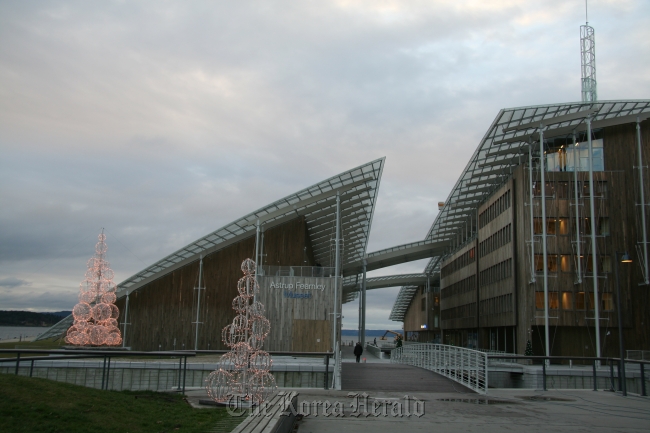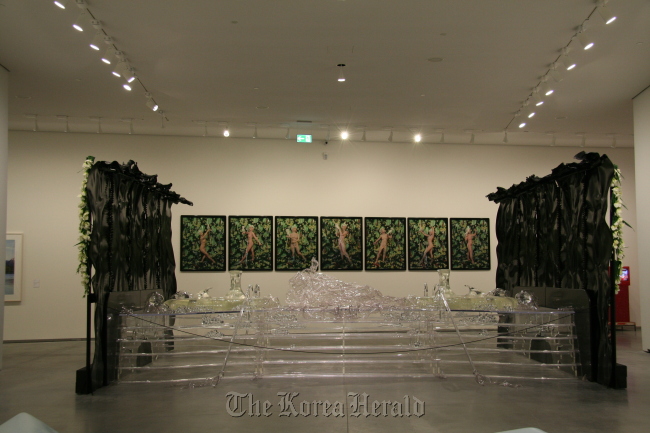Oslo as an art destination
Nordic city boasts world-class contemporary art museum, latest Nordic architecture
By Korea HeraldPublished : Dec. 19, 2012 - 20:20

OSLO ― Dusk falls at around 3 p.m. in Oslo, casting a gloomy grayish light over the city. The atmosphere soon changes dramatically, however, when the street lamps and the lights in numerous glass buildings come on. The city is basked in a warm amber glow, a perfect foil to the harsh cold of a Nordic winter evening.
While most Korean tourists visit Norway in the summer ― mostly on cruises where you can view up close the breathtaking fjords ― a day or two in Oslo can also yield surprisingly happy results.
Parts of Oslo are under large-scale urban redevelopment, highlighting modern architecture that is uniquely Nordic. Tjuvholmen Icon Complex, a newly redeveloped area that was formerly a harbor, is a delightful example of how interesting architecture can be attractions themselves. Featuring upscale eateries, art galleries and shops, the area is a must-see for visitors.
The newly relocated Astrup Fearnley Museum, situated at the tip of Tjuvholmen facing the fjord, is a treat for the eyes. Designed by Renzo Piano, an internationally acclaimed Italian architect, the museum building itself is a destination.
While most Korean tourists visit Norway in the summer ― mostly on cruises where you can view up close the breathtaking fjords ― a day or two in Oslo can also yield surprisingly happy results.
Parts of Oslo are under large-scale urban redevelopment, highlighting modern architecture that is uniquely Nordic. Tjuvholmen Icon Complex, a newly redeveloped area that was formerly a harbor, is a delightful example of how interesting architecture can be attractions themselves. Featuring upscale eateries, art galleries and shops, the area is a must-see for visitors.
The newly relocated Astrup Fearnley Museum, situated at the tip of Tjuvholmen facing the fjord, is a treat for the eyes. Designed by Renzo Piano, an internationally acclaimed Italian architect, the museum building itself is a destination.

The privately owned museum, which first opened in 1993, reopened at its current site in September. Along with the dramatic Opera House, designed to resemble an iceberg, Astrup Fearnley Museum is an iconic building that should put Oslo on any art lover’s map, for while the building is striking on its own, the collection it houses within is world class.
Greeting the visitors at the entrance of the building that shows temporary exhibitions is Takashi Murakami’s “3-meter Girl” which sets the tone for what you can expect at the museum.
The Astrup Fearnley Collection was started in the 1960s with a focus on key individual works and artists. The collection does not aspire to be an encyclopedic one; rather it focuses on a few significant artists who have continued to push the boundaries, showing the development and coherence of their work.
However, even to the uninitiated, the museum is a feast for the eyes. Many well-known contemporary artists are represented here ― Damien Hirst, Jeff Koons, Takashi Murakami and Cindy Sherman, among them ― surely names most people have heard or seen.
In fact, the museum is an excellent introduction to contemporary art even for novices as their curiosity will be sparked. Seeing firsthand Hirst’s “Mother and Child Divided,” two halves of a cow and a calf, each bisected and preserved in a tank of formaldehyde solution, will provoke and challenge viewers to discover what the artist was trying to communicate ― why a cow and a calf, why formaldehyde, why the bluish tint in the tank, why the wide frames?
While the museum in the past decade has concentrated on acquiring American contemporary artists and younger artists, more recently, it has shifted to major European, Brazilian, Japanese, Chinese and Indian contemporary artists. In fact, Chinese artists appear to have a huge presence in the exhibition space. Korean installation artist Koo Jeong-a’s “Snowy Sunny Days” can be found at the Nordic outpost of contemporary art.
Astrup Fearnley Museum’s inaugural exhibition at the new space, “To Be With Art is All We Ask,” curated from the museum’s own collection, runs through April 13, 2013.
Edvard Munch, who donated all his works to the city of Oslo, is the artist most associated with Oslo, the rather gloomy sensibilities and tormented atmosphere of his paintings seemingly reflecting the dull, grayness of Norwegian winters.
“The Modern Eye,” a special exhibition at the Munch Museum running through Feb. 17, shows the artist’s later paintings and works on paper along with his experiments with photography, offering a new insight into the artist.
Munch had a rather peculiar way of working: “I don’t paint what I see, I paint what I saw,” he said. The process involved the artist seeing a vision, writing it down and then painting, as if he worked through a lens to arrive at his final image.
Indeed, in the early 1900s, Munch became an amateur photographer, making several 8 mm movie clips. Perhaps it was interest in photography and films ― reproduction and reinterpretation are important to Munch’s works as seen in the “Vampire” and “Kiss” series that experiment with the same motif in different variations.
Munch’s best-known work “Scream” also comes four versions, in paintings and pastels. The 1910 painting edition of “Scream” and the pastel version from 1893 are housed at the Munch Museum.
By Kim Hoo-ran (khooran@heraldcorp.com)
-
Articles by Korea Herald









![[KH Explains] Hyundai-backed Motional’s struggles deepen as Tesla eyes August robotaxi debut](http://res.heraldm.com/phpwas/restmb_idxmake.php?idx=644&simg=/content/image/2024/05/16/20240516050605_0.jpg&u=20240516155018)









